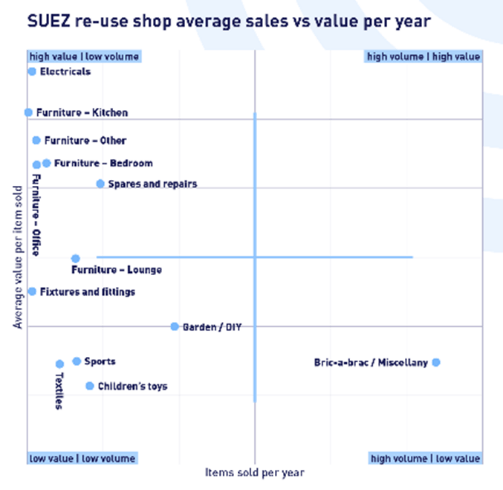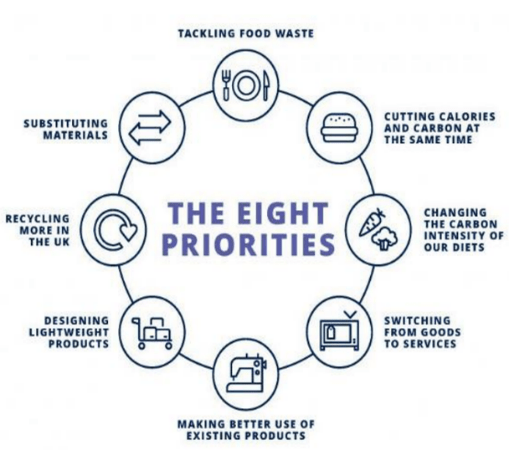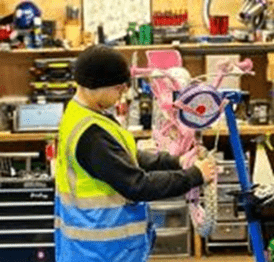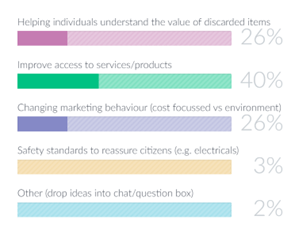Webinar highlights | Re-use: A missed opportunity
11th April 2023
Blog by Emily Nurse, Sustainability and Social Value Intern at SUEZ recycling and recovery UK.
In order for re-use and repair to become economically viable and the norm, it needs to be large-scale, accessible, and easy. As the third and final webinar in SUEZ’s three-part series on repair, released in conjunction with our latest re-use guide, ‘seizing the opportunity’, this session looked forward into the future of re-use. Chairing this week’s session, Dr Adam Read, Chief External Affairs and Sustainability Officer at SUEZ recycling and recovery UK, introduced the webinar before handing over to the expert panel, including Sarah Ottaway, Sustainability and Social Value Lead at SUEZ, Bettina Gilbert, Head of Technical Support and Financial Mechanisms at WRAP, Chris Stephenson, Chief Executive Officer at Environcom, and Paul Morgan, Head of Commercial Services at Greater Manchester Combined Authority (GMCA).
What are we missing?
 One of the biggest challenges with re-use is that you cannot control stock in the same way that a retail shop can, as it depends on what items people discard, and when they choose to do so. However, through years of data, trends and patterns have been captured from SUEZ’s network of 30 re-use shops across England and Scotland, finding that items with a higher value, such as electrical goods and furniture, are less likely to end up in a re-use shop, having a more obvious value attached to them. This data has also highlighted that more than 35,000 reusable items are being discarded or recycled every day in HWRCs across the country, instead of going to re-use. In total, that is 13 million items a year.
One of the biggest challenges with re-use is that you cannot control stock in the same way that a retail shop can, as it depends on what items people discard, and when they choose to do so. However, through years of data, trends and patterns have been captured from SUEZ’s network of 30 re-use shops across England and Scotland, finding that items with a higher value, such as electrical goods and furniture, are less likely to end up in a re-use shop, having a more obvious value attached to them. This data has also highlighted that more than 35,000 reusable items are being discarded or recycled every day in HWRCs across the country, instead of going to re-use. In total, that is 13 million items a year.
However, it isn’t just the items and sales that are being missed – social and environmental benefits are also being overlooked. The cost of buying something new as opposed to buying a pre-loved item has huge savings involved. On average, every tonne sold for re-use saves an estimated £373,000, compared with buying the same items new. There are also carbon savings being missed with re-use and repair. If the sector can continue to grow (as it can and should!), by 2028 we could be reusing and repairing more than 15 million items. That is the equivalent of taking 189,000 cars off the road.
What’s the scale of opportunity?
Based on an average sale of 15 million items, the sale revenue generated from re-use and repair would be in excess of £63 million. Critically, that money could support services and waste prevention activities or could go back to local community through grants and funds, as it currently is through the Greater Manchester reuse network. Forty thousand jobs would be created, and we would save more than 930,000 tonnes of carbon emissions every year. But to do this, central government must set policies that enable the right conditions for re-use and repair, set targets, capture the right data, and must have ambition to drive re-use forward.
Why reuse and repair?
Bettina Gilbert from WRAP explained the importance of re-use for the UK to reach the net zero target. WRAP’s 2021 report, ‘NET ZERO: Why resource efficiency holds the answers’ examined the potential of eight different material strategies, each with great potential to aid our journey towards net zero. Importantly, one of the priorities, ‘making better use of existing products’, was all about re-use and repair. WRAP’s report found that by extending the product lifetime of items through re-use activities, a cumulative saving of 380 million tonnes of carbon can be saved by 2050.

Image credit: WRAP
Yet, there must still be a business case for re-use. Extensive carbon savings generated through re-use and repair are, of course, a critical benefit, but there must be an economic benefit in order for it to be viable. Another WRAP report, also published in 2021, walked through differing types of circular economy interventions at different scales – for example, what could happen under a ‘business as usual’ scenario, versus ‘some investment’, versus a transformational scenario. Examining the latter, the report found that re-use and repair would provide a staggering net GVA gain of £3 billion per annum into the economy.
Re-use becoming the norm
For the next part of the webinar, Chris Stephenson from Environcom, started by explaining that as the largest independent Waste Electrical and Electronic Equipment recycling and re-use business in the UK, they now sell 90% of their white goods to UK charities, and always provide a guarantee to the customer. They are currently the only re-use business that supply an at home guarantee service, ‘Peace of Mind’. If the item purchased doesn’t work, an engineer is called out, and if the item cannot be repaired, Environcom will replace the product. With a return rate of only 4.7%, lower than the new product rate of 5%, it appears that pre-loved items are able to have a successful second lease of life when the right process is in place.
For re-use to become incorporated into everyday behaviour, Chris drew attention to several initiatives that could help, for example, electrical stores selling both new and used electrical products, providing buyers with the ‘ultimate’ choice, and buying second hand items acceptability. Additionally, he highlighted there should be no sales tax, or VAT, on re-used products, as customers have already paid this on the new product! To ensure that the item is safe and in good condition, a government-controlled certificate could be introduced, inspected annually, and with each item being barcoded to aid traceability. Chris also suggested that the producer should pay based on whether the item can be recycled or re-used, or not, with a tax being charged up front. The producer will then ultimately have to increase the cost on items that cannot be re-used or repaired, benefiting those that can.
Re-use in Greater Manchester – thinking into the future
Our final panellist, Paul Morgan from GMCA, presented on the re-use scene in Greater Manchester. Initially, items are dropped off at local HWRCs – if diverted for re-use, they can be sent to SUEZ’s Renew Hub to be repaired or refurbished, before ending up in a retail outlet to be sold for a second lease of life. The retail outlets in Manchester take the form of being sold through a local charity shop, through the Renew Hub’s eBay page, or in one of the three reuse shops in Manchester. Up to the end of February, GMCA saw 116,000 items come through the Renew Hub, where there is an approximate £700 value per tonne.
 Plans for the future of reuse in Manchester are ambitious, but they have a vision, and with the clear success of the Renew Hub having already been seen, the possibility of a second Hub being built is now on the cards. Alongside this, SUEZ’s proposal for a fifth re-use shop in Greater Manchester has been put forward, as well as the possibility of looking into a city centre retail premises, and increased pop-up shops too. Not only this, but the GMCA continue to look at wider partnerships with the private and public sector, including the educational sector, and NHS, where items such as walking aids, crutches, and other medical equipment commonly come through HWRCs, and have great potential for reuse.
Plans for the future of reuse in Manchester are ambitious, but they have a vision, and with the clear success of the Renew Hub having already been seen, the possibility of a second Hub being built is now on the cards. Alongside this, SUEZ’s proposal for a fifth re-use shop in Greater Manchester has been put forward, as well as the possibility of looking into a city centre retail premises, and increased pop-up shops too. Not only this, but the GMCA continue to look at wider partnerships with the private and public sector, including the educational sector, and NHS, where items such as walking aids, crutches, and other medical equipment commonly come through HWRCs, and have great potential for reuse.
Q&A
The webinar provoked a number of questions from Adam and the audience and the highlights for me were:
Are the public really ready for reuse and repair? Can it become the norm?
Bettina: Wales are making excellent progress – the public are definitely ready! We have already seen a massive growth in reuse platforms and websites, selling clothes and other goods online. There are actually probably more goods available than people want to buy. However, with that said, we need to make it a social norm – it needs to become more than just selling second hand clothing and electrical goods.
Sarah: I agree. To add to Bettina’s point, an ONS report came out last month, showing that throughout 2022 there was a month on month increase on second hand goods sales. There was also an increase in retail sales in the first two months of the year, and part of that was due to second hand goods, which was highlighted in the report as an area of growth.
How do we get hold of data to help with reuse and repair, and is reuse financially viable?
Paul: In Manchester, re-use and repair only really took off when SUEZ came along, as they helped in providing the commercial and retail aspect to it. Honestly, it’s a lot of guess work at the start – but you just have to get stuck in there! The operation of re-use at a higher level does need to be carried out very commercially. You need to know when to put something in a skip, and not to keep it in a corner ‘just in case!’ Perhaps it doesn’t need to pay for itself – there are other benefits, it isn’t a purely economic driven model.
What’s the most important action we need to take to normalise behaviours surrounding re-use?
 In response to the audience poll question, the majority (40%) argued that there needs to be improved access to services and products. Chris disagreed, stating that there needs to be taxation at the front end, and that the producer needs to pay, or reuse must be DPR driven.
In response to the audience poll question, the majority (40%) argued that there needs to be improved access to services and products. Chris disagreed, stating that there needs to be taxation at the front end, and that the producer needs to pay, or reuse must be DPR driven.
In contrast, and agreeing with 26% of the audience, Bettina highlighted that the most important action is ‘helping individuals understand value of discarded items’. She argued that many people won’t look to repair first, they’ll simply go for the easiest option, and may not understand impact and value of what they’re throwing away, along with the labour that went into it! In order for things to change, Bettina stated that we need universal behaviour change, and to raise awareness.
If you’d like the hear full scoop and the poll questions posed by Dr Adam Read, along with the answers from the expert panel, head over to watch the recording of the webinar here.
This webinar gave plenty of food for thought, highlighting the power and potential that re-use and repair has in terms of social value, carbon savings and skillset development, while calling out the need for clearer government targets, incentives and more collaborative approach to facilitate behavioural changes in the society. Re-use and repair are certainly not something to be swept under the carpet – but will we see the policy that we need to really get it off the ground? Only time will tell.
To watch the recording of the webinar in full, click here.
Tweet